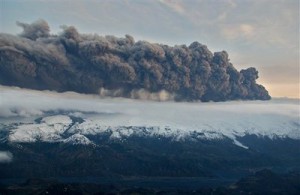Navigating the Volcanic Ash Cloud
Airlines across central and northern Europe have continued to struggle with cancelled flights due to the massive cloud of volcanic ash from the eruption of Iceland’s Eyjafjallajokull volcano on March 20.

Throughout the last week, over 95,000 flights have been cancelled. According to a BBC News article, the flight delays and cancellations are not only frustrating travelers, but causing problems in world business.
Automobile manufacturers can’t acquire their car parts. Phone and clothing companies have no way to ship their products, and distributors of perishable goods like vegetables and plants are being forced to throw their products in the garbage.
The ash cloud is affecting manufacturers, but it’s obviously affecting the airline industry much more significantly. Sources say the airline industry loses approximately $200 million each day the ash forces them to cancel so many flights.
But its just an ash cloud, right? What’s the big deal? It might be surprising, but the ash cloud brings more dangers than just bad vision. If the volcanic ash particles enter the engine turbine of a plane, the heat within that turbine would turn the ash into molten glass. This can seriously damage the engine and cause the plane to crash.
It has been speculated that the trouble could fade significantly within a few days and some flights have begun taking off. Unfortunately, history repeats itself and it very well could happen now. The last time this volcano erupted was in 1821 and it continued to exude ash clouds for over a year.
Engineers and scientists are working to create solutions for this problem, ones that could curb the issue in the future. Many ideas are being proposed to somehow utilize our flight systems by working around the cloud. While flying below the cloud of ash is one option, it is a dangerous one. The major concern with flying aircrafts near and around the ash cloud is disrupted vision and the possibility of a crash.

Other ideas involve improving our technology. Engineers are working on engine turbines that will be able to withstand the problems that are caused by volcanic ash so that, in the future, a massive section of the world is not put on pause by an eruption.
For now we can hope the cloud dissipates sooner than later, but work must be done to avoid a problem like this in the future. Scientists and engineers plan to send planes into the cloud, without passengers of course, to learn more about its effects.
Some people have complained about the delay, deeming it unnecessary, but safety in flying is more important than safety in most other modes of transportation. If your car suddenly shuts down, you will roll to a stop. In a plane, you won’t be so lucky.

I agree with your comments. If I was stranded in an airport for several days, I’m sure I would be
complaining and grumpy. But I know I would rather be safe on the ground than flying through
volcanic ash! This is one of “nature’s events” that just happen and no one can be blamed for it.